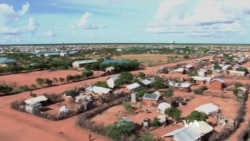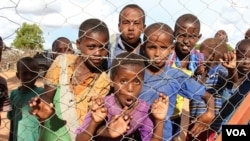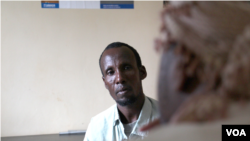When Bilado Hassan came to the Kenyan town of Dadaab in 1992, the future home of Africa’s largest refugee camp was nothing more than an open expanse of dry, dusty land spotted with a few low-lying scrubby bushes.
“We were brought here, a place with just open land, no trees, no houses and so much wind,” she says.
Hassan fled her home in Mogadishu at the start of Somalia's civil war, which would rumble along for more than 20 years to the present day.
“At first I was hopeful that I would go back home, but after about a year or two, the fighting got worse,” she says. “I accepted that I would live here.”
Her 21-year-old daughter, Safia, was born in the camps, married another refugee and now has two children of her own. One family, three generations of refugees.
While her mother remembers a better life in Mogadishu, Safia does not.
“I’m happy to be born here,” she says. “This is the place where I am from and I’ve had my own family. I’ve never been anywhere else.”
They are among the 350,000 refugees, mostly from Somalia, living at the Dadaab camps in northeastern Kenya whose lives may soon by uprooted by a government directive to close down the camps and repatriate refugees to Somalia.
A Post-Garissa World
Kenya has repeatedly tried to reduce the refugee population in the country because of security concerns. But the final straw was the April 2 terrorist attack on Garissa University College, when gunmen from the Somalia-based militant group al-Shabab slaughtered 148 people, most of them students, in a merciless assault on the campus.
Kenya blamed the attack on homegrown terrorists and pointed fingers at the Somali refugee population at Dadaab, located exactly halfway between between Garissa and the Somali border.
On April 11, Kenyan Deputy President William Ruto announced the government had asked the United Nations to close down the camps within three months.
“The way America changed after 9/11 is the way Kenya will change after Garissa,” he said.
Refugees have reacted to the move with a combination of fear and resignation.
“The country is kind of sliding backwards,” says Ibrahim Hussein, a refugee seeking voluntary repatriation. “Each time there’s an attack, they say, "It’s the refugees and they have to be taken back.'"
Refugee City
Top officials from the United Nations refugee agency, UNHCR, are meeting with the Kenyan government to discuss efforts to relocate the camps while warning of the humanitarian consequences of the move.
An enormous aid operation supports life in Dadaab. The Red Cross, the International Rescue Committee and Doctors Without Borders run hospitals and clinics within the camps. The UNHCR supports the local police force, while 76,000 households receive food rations from the U.N. World Food Program.
About 90,000 students are enrolled in 35 primary schools and nearly 100,000 children have been born in the camps since they first opened.
But the complex is not just a feeding center with free foreign handouts; it is more like a small town, an economy integrated and inseparable from the local community.
There are refugee-owned restaurants, butcheries, clothing stores, banks and phone shops all within the boundaries of the camp. Closing it down would uproot the livelihoods of its residents and undermine the local economy, not just for refugees, but for the host community as well.
Kill or Be Killed
The Kenya government has one thing right: insecurity is a serious problem in the camps. In 2011, two Spanish aid workers were kidnapped from the site and held in Somalia for more than two-and-a half years. A U.N. security official said there have been at least 20 IED attacks in the past three years, mostly targeting police.
But whether these are the acts of al-Shabab or other militant groups is difficult to verify.
While Kenya has blamed recent violence on al-Shabab cells located in Dadaab, there is little direct evidence of the group’s activities there.
But residents of Dadaab are afraid that more youths could end up joining armed groups if they are forced to relocate to Somalia, where there are fewer opportunities for education and where the government still fails to provide basic services in areas recently “liberated” from al-Shabab.
“Most of these youths will be taken to a country they don’t know and they will either be killed or kill someone,” says Mohammed Yusuf an 80-year-old elder at Ifo camp.
Using a Somali idiom, he says the United Nations and Kenya will be wasting all their efforts to educate and protect refugees if they are sent to Somalia, like “taking a happy animal away from its pasture.”
Should I Stay or Should I Go?
UNHCR runs a voluntary repatriation program to support refugees who want to go back to Somalia. The agency provides cash assistance to those who want to go back to Baidoa, Luuq and Kismayo - three areas deemed safe enough for people to return.
Those who want to settle elsewhere in Somalia are welcome to go, but will not receive any U.N. money.
From December to March, only about 2,000 refugees took part in the voluntary return program. A UNHCR repatriation assistant said he has seen the numbers increase since Deputy President Ruto issued the order to close the camps.
Despite the incentives, the decision to stay in limbo or to venture back to unstable and unfamiliar territory is a tough call for many refugees who feel neither Kenyan nor completely Somali.
Hassan Ahmed Mohamed, raised in Dadaab’s Ifo camp, simply refers to himself as an “Iforian.”
Abandoned by his family as a boy in Somalia, he has no life waiting for him if he is forced back and is now torn between the country of his birth and the country of his upbringing.
“I’m a Somali by blood, by color, by nationality, by language,” he says. “But my heart says Kenya just because I only know Kenya.”
VOA's Mohammed Yusuf contributed to this report.














